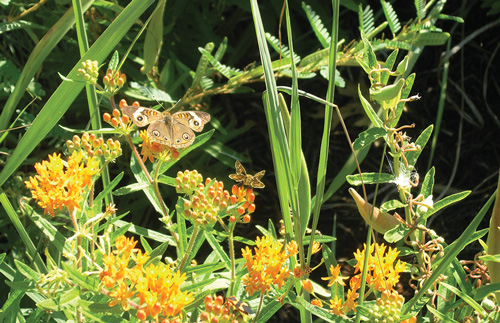 Protecting our environment, one stormwater practice at a time.
Protecting our environment, one stormwater practice at a time.
Open Space — Meadows
Overview
A meadow is an open area of land with few or no trees, vegetated with native grasses and wildflowers. Plants in this habitat provide food and shelter for wildlife. More stormwater infiltrates into a meadow than a turf field because native plants create void spaces in the soil through deep root growth.
How Meadows Work
Native meadow plants have deep roots which create spaces in the soil as they grow, allowing more water to soak into the ground. Turf grass has a shallow root system. Native meadow plants are more suited to Virginia’s climate and do not require the same intensity of care as non-native species. Replacing turf grass with a meadow provides many benefits, including.
- Wildlife food and habitat
- Less maintenance
- Improved water quality
- Groundwater recharge
- Improved soil infiltration
- Erosion control
Infiltration is a process where water on the ground soaks into the underlying soil by traveling through void spaces (pores) between soil particles. Compacted soils have smaller void spaces which causes more stormwater runoff and less infiltration. The potential for stream erosion increases as additional runoff flows overland instead of infiltrating into the soil.
Manually remove all turf grass and weeds before planting a meadow. Tilling the soil will reduce soil compaction and break up any remaining root systems. Plant selection will depend on the site conditions of the area including soil characteristics. Meadows should be established by the third growing cycle.
How to Maintain a Meadow
- Mow the meadow four times in the first year to a height of 6 to 8 inches to encourage good root development in perennial flowers and grasses
- After the first year, mow annually in late winter or early spring
- Invasive species should be removed throughout the year and native plants should be replaced when necessary
 FairFacts
FairFacts
- Monarch Butterfly (Danaus plexippus) caterpillars depend on the milkweed plants as their food source. Milkweed plants require sunny, open places like meadows to grow.<
- There are wet meadows and dry meadows. Different plants are suited to these habitats.
- An invasive plant species is a non-native species that outcompetes native flora.
- After the first year, mow annually in late-winter or early-spring to provide food and cover for wildlife during the winter.
- Filter strips or open space practices may incorporate a meadow.
Restoring Habitat
Why is this meadow here?

Pollinator Meadows clean our water and provide a home for valuable animals. A meadow is an open area of land with native grasses and wildflowers. These plants clean our water by acting as filters, trapping pollutants, like salt and litter, before they reach our streams and the Chesapeake Bay. Unlike turf grass, native plants also have deep root systems. These roots create open spaces in the soil, allowing water to soak into the ground. This reduces the amount of water that flows over land into our streams which reduces stream erosion.
These plants provide food and habitat to a wide range of wildlife, including pollinator species like butterflies, bees, and hummingbirds. Pollinators are responsible for fertilizing many of the plants that provide us with food, medicine, and other resources. Monarch butterfly caterpillars depend on milkweed plants for food. Milkweed plants require sunny, open spaces like meadows to grow. Without pollinators, any of these plants would not be able to reproduce, which would have a significant impact on our ecosystems and food supply.
The information in this fact sheet is general in nature and is not intended to determine maintenance responsibility.
For more information, contact:
Department of Public Works and Environmental Services, Maintenance and Stormwater Management Division
10635 West Drive, Fairfax, VA 22030
703-877-2800, TTY 711
ContactMSMD@fairfaxcounty.gov

